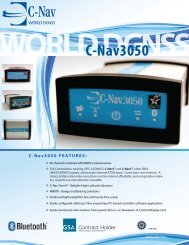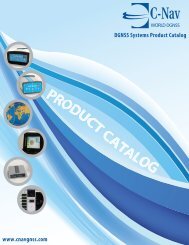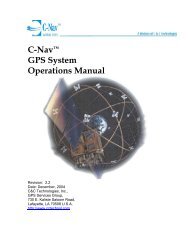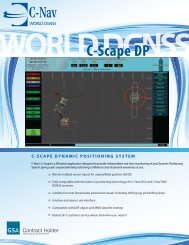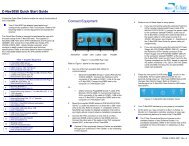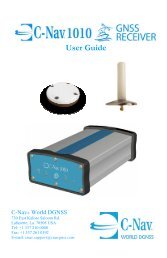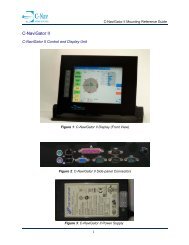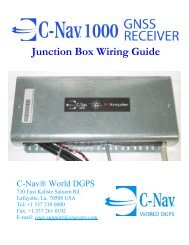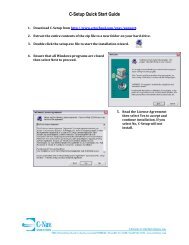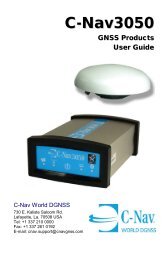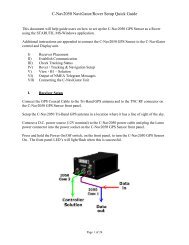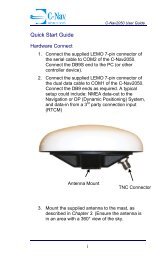Guidelines for the use of GNSS in surveying and mapping
Guidelines for the use of GNSS in surveying and mapping
Guidelines for the use of GNSS in surveying and mapping
You also want an ePaper? Increase the reach of your titles
YUMPU automatically turns print PDFs into web optimized ePapers that Google loves.
The field procedures adopted should <strong>in</strong>corporate<br />
<strong>the</strong> follow<strong>in</strong>g best practice guidel<strong>in</strong>es:<br />
+ <strong>the</strong> base stations should be part <strong>of</strong> an exist<strong>in</strong>g<br />
or previously surveyed network, with accurate<br />
co-ord<strong>in</strong>ates to better than ± 5m <strong>in</strong> ITRS89<br />
+ <strong>the</strong> technique should be limited to 10–15km<br />
basel<strong>in</strong>es<br />
+ if fur<strong>the</strong>r base station set-ups are <strong>use</strong>d (<strong>for</strong><br />
example <strong>in</strong> a long l<strong>in</strong>ear survey), <strong>the</strong>se should<br />
be tied as part <strong>of</strong> a ma<strong>in</strong> network to o<strong>the</strong>r base<br />
stations <strong>use</strong>d. The survey should also <strong>in</strong>clude<br />
common po<strong>in</strong>ts, observed from each adjacent<br />
base<br />
+ take antenna phase centre variations <strong>in</strong>to<br />
account if different types <strong>of</strong> antenna are <strong>use</strong>d<br />
+ if any new tertiary level control is observed,<br />
each new station should be co-ord<strong>in</strong>ated twice,<br />
once from each <strong>of</strong> two base control stations to<br />
ensure an <strong>in</strong>dependent check<br />
+ both receivers must ma<strong>in</strong>ta<strong>in</strong> lock on at least<br />
four satellites throughout <strong>the</strong> session, hence<br />
this technique should only be <strong>use</strong>d <strong>in</strong> areas<br />
where loss <strong>of</strong> lock is likely to be m<strong>in</strong>imal, e.g.<br />
open spaces, clear <strong>of</strong> vegetation <strong>and</strong> structures<br />
+ on start<strong>in</strong>g survey <strong>for</strong> <strong>the</strong> day, once <strong>the</strong> receiver<br />
has completed <strong>in</strong>itialisation it is good practice<br />
to make a separate check on a known station,<br />
to ensure <strong>the</strong> receiver has <strong>the</strong> correct <strong>in</strong>teger<br />
solution <strong>and</strong> <strong>the</strong> base has <strong>the</strong> correct coord<strong>in</strong>ates<br />
+ when a loss <strong>of</strong> lock occurs dur<strong>in</strong>g <strong>the</strong> survey, a<br />
previously co-ord<strong>in</strong>ated po<strong>in</strong>t should be<br />
revisited <strong>in</strong> order to check <strong>the</strong> re-<strong>in</strong>itialisation <strong>of</strong><br />
<strong>the</strong> receiver.<br />
There are also more specific issues that relate to<br />
quality control <strong>of</strong> real-time systems; <strong>the</strong>se are<br />
covered <strong>in</strong> detail <strong>in</strong> section 7.4.<br />
7.3.5 Medium <strong>and</strong> low-order detail surveys<br />
For detail surveys, or position<strong>in</strong>g that requires a<br />
precision at <strong>the</strong> 100mm to 1m level, differential<br />
<strong>GNSS</strong> techniques can be <strong>use</strong>d. These can be realtime<br />
or post-processed, <strong>and</strong> <strong>in</strong> all cases <strong>the</strong><br />
surveys are not subject to <strong>the</strong> same loss <strong>of</strong> lock<br />
criteria as higher-order surveys. The guidel<strong>in</strong>es<br />
below could be followed <strong>for</strong> fieldwork:<br />
+ occupy known po<strong>in</strong>ts dur<strong>in</strong>g <strong>the</strong> survey – <strong>the</strong>se<br />
could be ei<strong>the</strong>r national control po<strong>in</strong>ts, or o<strong>the</strong>r<br />
control po<strong>in</strong>ts <strong>in</strong> <strong>the</strong> survey area measured<br />
us<strong>in</strong>g a higher-precision method<br />
+ observe map check po<strong>in</strong>ts if data is to be fitted<br />
to a background map. This will ensure <strong>the</strong> data<br />
is consistent with a map background <strong>and</strong> will<br />
allow <strong>the</strong> accuracy <strong>of</strong> <strong>the</strong> background map to<br />
be assessed;<br />
+ ensure <strong>the</strong> positional data logged <strong>in</strong>cludes <strong>the</strong><br />
number <strong>of</strong> satellites, DOP values, estimated<br />
precision <strong>and</strong> <strong>the</strong> st<strong>and</strong>ard deviation <strong>of</strong> any<br />
multiple D<strong>GNSS</strong> positions logged <strong>for</strong> a po<strong>in</strong>t<br />
+ try to <strong>use</strong> <strong>the</strong> equipment where clear sky views<br />
are available. Despite manufacturers’ claims<br />
that D<strong>GNSS</strong> equipment will work <strong>in</strong> wooded<br />
<strong>and</strong> o<strong>the</strong>r enclosed areas, it is best practice to<br />
<strong>use</strong> ano<strong>the</strong>r survey method <strong>in</strong> such areas, <strong>for</strong><br />
example a laser distance/compass system to<br />
provide <strong>of</strong>fset po<strong>in</strong>ts <strong>in</strong> low-precision<br />
applications.<br />
7.3.6 Static position<strong>in</strong>g<br />
Due to lower accuracy requirements, <strong>the</strong> quality<br />
control <strong>of</strong> <strong>the</strong> field procedures <strong>for</strong> position<strong>in</strong>g tasks<br />
is far less rigorous than <strong>for</strong> static or dynamic<br />
surveys. The ma<strong>in</strong> quality issue is to ensure <strong>the</strong> file<br />
name <strong>for</strong> any logged data is noted <strong>and</strong> booked <strong>in</strong><br />
<strong>the</strong> field, with <strong>the</strong> po<strong>in</strong>t names. The manufacturers<br />
<strong>of</strong> <strong>GNSS</strong> <strong>in</strong>struments provide waypo<strong>in</strong>t storage <strong>for</strong><br />
po<strong>in</strong>ts, <strong>and</strong> <strong>the</strong>se should be <strong>use</strong>d to log general<br />
po<strong>in</strong>ts <strong>in</strong> <strong>the</strong> field. It is also best practice to keep a<br />
copy <strong>of</strong> all co-ord<strong>in</strong>ate data <strong>in</strong> ITRS89 <strong>for</strong> later<br />
trans<strong>for</strong>mation if required. This will ensure <strong>the</strong><br />
desired co-ord<strong>in</strong>ate trans<strong>for</strong>mation is <strong>use</strong>d, which<br />
may not be <strong>the</strong> one supplied by <strong>the</strong> manufacturer<br />
<strong>in</strong> <strong>the</strong> <strong>GNSS</strong> receiver.<br />
7.4 Quality control <strong>of</strong> real-time systems<br />
Real-time systems are a highly productive <strong>GNSS</strong><br />
technique, <strong>in</strong> that <strong>the</strong> surveyor knows <strong>the</strong> system<br />
has worked <strong>and</strong> that sufficient data has been<br />
logged be<strong>for</strong>e vacat<strong>in</strong>g <strong>the</strong> site. The surveyor<br />
knows immediately that <strong>the</strong> data has been<br />
successfully captured at a suitable level <strong>of</strong><br />
precision, although <strong>the</strong> absolute accuracy is<br />
unknown.<br />
As no post-process<strong>in</strong>g <strong>and</strong> adjustment is available<br />
to provide statistical analysis, <strong>the</strong> quality control<br />
parameters <strong>for</strong> <strong>the</strong>se surveys must be available <strong>in</strong><br />
real time to <strong>the</strong> surveyor.<br />
52 | GUIDELINES FOR THE USE OF <strong>GNSS</strong> IN LAND SURVEYING AND MAPPING



